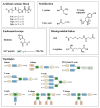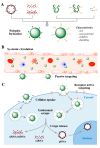Non-Viral Targeted Nucleic Acid Delivery: Apply Sequences for Optimization
- PMID: 32961908
- PMCID: PMC7559072
- DOI: 10.3390/pharmaceutics12090888
Non-Viral Targeted Nucleic Acid Delivery: Apply Sequences for Optimization
Abstract
In nature, genomes have been optimized by the evolution of their nucleic acid sequences. The design of peptide-like carriers as synthetic sequences provides a strategy for optimizing multifunctional targeted nucleic acid delivery in an iterative process. The optimization of sequence-defined nanocarriers differs for different nucleic acid cargos as well as their specific applications. Supramolecular self-assembly enriched the development of a virus-inspired non-viral nucleic acid delivery system. Incorporation of DNA barcodes presents a complementary approach of applying sequences for nanocarrier optimization. This strategy may greatly help to identify nucleic acid carriers that can overcome pharmacological barriers and facilitate targeted delivery in vivo. Barcode sequences enable simultaneous evaluation of multiple nucleic acid nanocarriers in a single test organism for in vivo biodistribution as well as in vivo bioactivity.
Keywords: DNA-barcode; non-viral; nucleic acid delivery; peptide; pharmacological barriers; sequence-defined; supramolecular self-assembly; tumor-targeted.
Conflict of interest statement
There are no conflicts to declare.
Figures






Similar articles
-
Optimizing synthetic nucleic acid and protein nanocarriers: The chemical evolution approach.Adv Drug Deliv Rev. 2021 Jan;168:30-54. doi: 10.1016/j.addr.2020.03.005. Epub 2020 Apr 1. Adv Drug Deliv Rev. 2021. PMID: 32246984 Review.
-
Optimizing Nucleic Acid Delivery Systems through Barcode Technology.ACS Synth Biol. 2024 Apr 19;13(4):1006-1018. doi: 10.1021/acssynbio.3c00602. Epub 2024 Mar 25. ACS Synth Biol. 2024. PMID: 38526308 Review.
-
Nucleic acid delivery to mesenchymal stem cells: a review of nonviral methods and applications.J Biol Eng. 2019 Jan 18;13:7. doi: 10.1186/s13036-019-0140-0. eCollection 2019. J Biol Eng. 2019. PMID: 30675180 Free PMC article. Review.
-
Polymers for siRNA delivery: inspired by viruses to be targeted, dynamic, and precise.Acc Chem Res. 2012 Jul 17;45(7):1005-13. doi: 10.1021/ar2002232. Epub 2011 Dec 22. Acc Chem Res. 2012. PMID: 22191535
-
Peptide-Assisted Nucleic Acid Delivery Systems on the Rise.Int J Mol Sci. 2021 Aug 23;22(16):9092. doi: 10.3390/ijms22169092. Int J Mol Sci. 2021. PMID: 34445799 Free PMC article. Review.
Cited by
-
Vibropolyfection: coupling polymer-mediated gene delivery to mechanical stimulation to enhance transfection of adherent cells.J Nanobiotechnology. 2022 Aug 6;20(1):363. doi: 10.1186/s12951-022-01571-x. J Nanobiotechnology. 2022. PMID: 35933375 Free PMC article.
-
NK Cells Armed with Chimeric Antigen Receptors (CAR): Roadblocks to Successful Development.Cells. 2021 Dec 1;10(12):3390. doi: 10.3390/cells10123390. Cells. 2021. PMID: 34943898 Free PMC article. Review.
-
Effect of Different Karyophilic Peptides on Physical Characteristics and In Vitro Transfection Efficiency of Chitosan-Plasmid Nanoparticles as Nonviral Gene Delivery Systems.Mol Biotechnol. 2025 Feb;67(2):723-733. doi: 10.1007/s12033-024-01087-9. Epub 2024 Feb 24. Mol Biotechnol. 2025. PMID: 38400988 Free PMC article.
-
Non-viral Vectors in Gene Therapy: Recent Development, Challenges, and Prospects.AAPS J. 2021 Jun 2;23(4):78. doi: 10.1208/s12248-021-00608-7. AAPS J. 2021. PMID: 34076797 Free PMC article. Review.
References
-
- Tabernero J., Shapiro G.I., LoRusso P.M., Cervantes A., Schwartz G.K., Weiss G.J., Paz-Ares L., Cho D.C., Infante J.R., Alsina M. First-in-humans trial of an RNA interference therapeutic targeting VEGF and KSP in cancer patients with liver involvement. Cancer Discov. 2013;3:406–417. doi: 10.1158/2159-8290.CD-12-0429. - DOI - PubMed
Publication types
Grants and funding
LinkOut - more resources
Full Text Sources
Other Literature Sources

